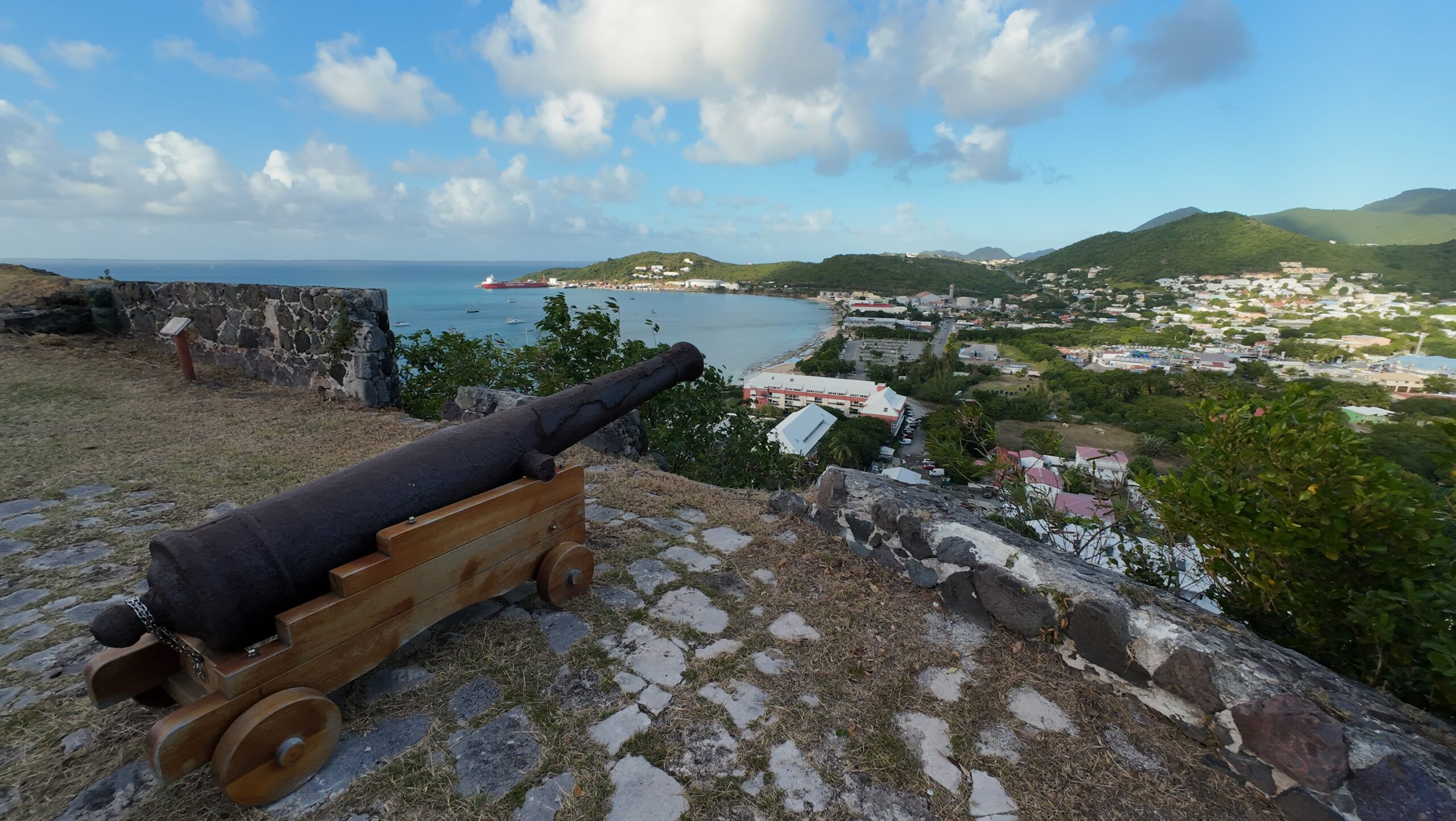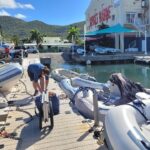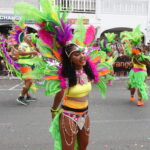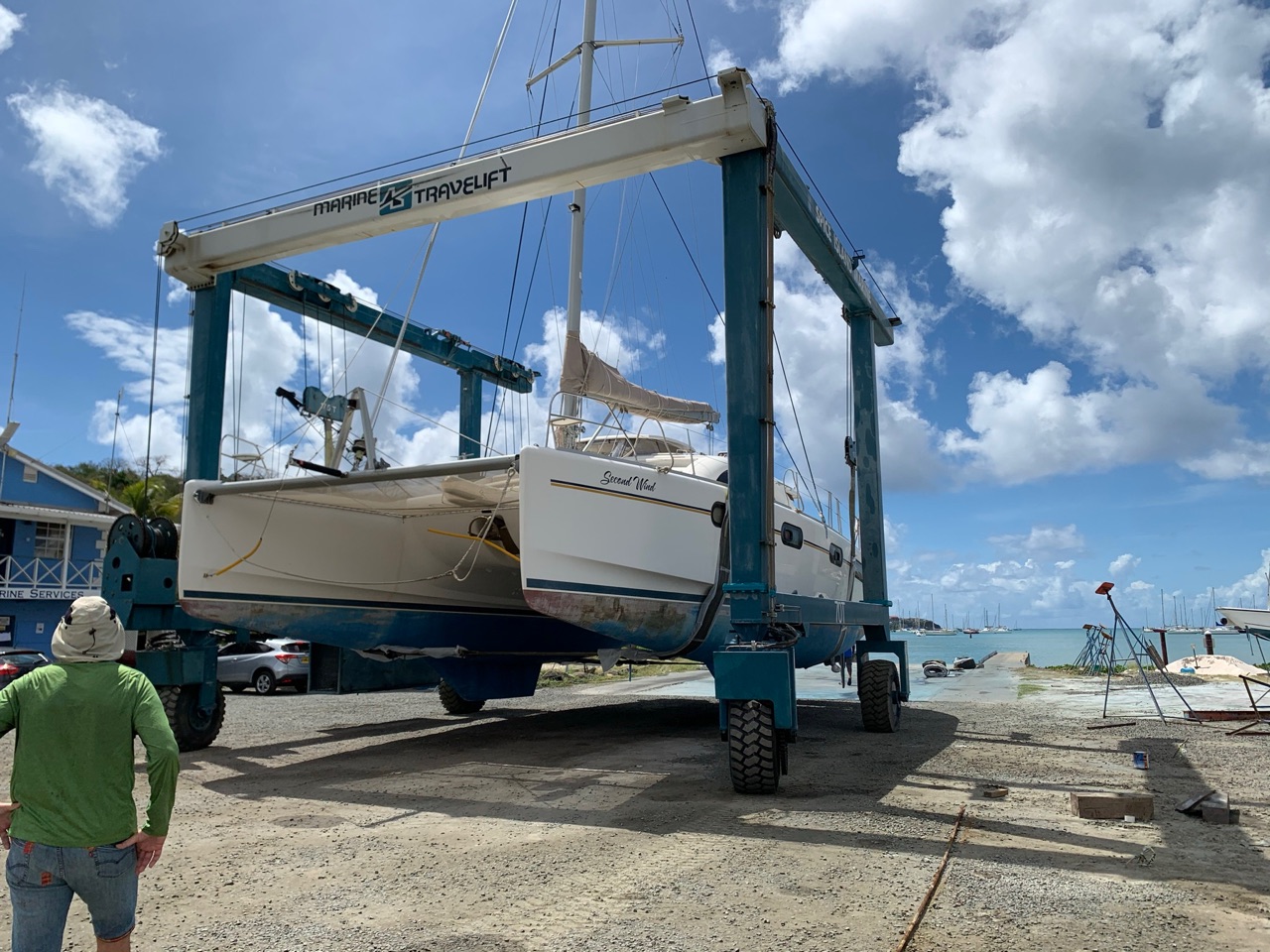An iconic destination in the Caribbean Sea, Saint Martin is home to French Saint Martin and Dutch Sint Maarten. Together, they make up one of the busiest and most useful cruiser hubs in the Caribbean.
Last sailing season we launched relatively late, having spent almost 2 years in a Trinidadian shipyard undergoing repairs. Despite all that time there was still more to do, so we decided to sail somewhere new and continue the work there. Our goal was to head to an island that was convenient and social, with protected anchorages and things to do in between boat work. After speaking to other cruisers, we pointed our bows towards the dual-nation island of Saint Martin.
We ended up spending about three months there, quickly understanding why it attracts so many yachts; everything a cruiser might need is within reach.
Sint Maarten vs Saint Martin
The island is split roughly in half, with Saint Martin (the French side) on the north and Sint Maarten (the Dutch side) on the south. On the western side is a large lagoon, which is also split between the French and Dutch sides.
To me, Sint Maarten feels more fast-paced. Simpson Bay around to Long Bay was very popular with tourists, the lagoon is a major super yacht hub, and the capital city, Philipsburg, has a large cruise ship port. For cruisers, this side of the island is home to many of the marinas, chandlers, suppliers, marine trades and has duty free imports, which is great if you need to ship something in!
Saint Martin has a completely different feel; more relaxed, with a distinctly European flair. Bakeries serve fresh baguettes, there are French wine and pastries readily available, and some wonderful French restaurants like the unforgettable Tropicana. As cruisers you won’t find the same level of marine services here, but you will enjoy a slower pace.
- Fort Louis, Marigot
Language and currency
Sint Maarten runs off two currencies, the local Caribbean guilder (XCG) and the US dollar. Which one you use is up to you, but we found the US dollar was more popular, with most shops, restaurants and marine industry businesses giving prices in USD first. While Dutch is technically the official language, English is what’s used by the majority of people and businesses.
Over on the French side, prices are in Euros, and French is the main spoken and written language. Something we found handy to know is some of the ATM’s there dispense EUR and USD, often with no ATM fees.
- Great Bay from Fort Amsterdam in Sint Maarten
Entering Sint Maarten or Saint Martin
Most cruisers arrive either from the Virgin Islands to the west or from further down the Lesser Antilles chain, like we did coming up from Guadeloupe. How you handle the entry processes depends one which side you’re anchoring on, as there are separate customs and immigration on each side of the island.
In French Saint Martin, you can clear in using a computer terminal at one of the designated entry points, like Ile Marine, or use the new online system at Demarches-Simplifees like we did. If you’re using a mooring ball at Marigot Bay you must visit the Port Authority at the Marigot Ferry Terminal to pay for it.
For Dutch Sint Maarten, most cruisers clear in at Customs & Immigration near Simpson Bay. You must visit in person with your documents, and if you have pets aboard a pet importation permit is necessary.
If you’re switching between the two sides, you are meant to check out and check in.
- Marigot Ferry Terminal
- Simpson Bay Station
Anchorages
There are a few main anchorages on both the French and Dutch sides, which have proven popular with cruisers.
The Lagoon (French/Dutch) – Accessible through drawbridges at Simpson Bay and Marigot Bay, the lagoon tends to be popular for long term visitors or people seeking a flat anchorage, although the water is not considered clean enough for a watermaker.
Marigot Bay (French) – A huge bay that can get surprisingly full, it provides easy access to the town of Marigot via the public dinghy dock. The best spot depends on the wind angle, but you do want to anchor away from the ferry route as they throw a big wake.
Grand Case (French) – More exposed to the north, Grand Case is known for its French-Caribbean restaurants and beach bars. With the right wind it’s a nice spot for good food and swimming, and also has some boutique shopping.
Philipsburg (Dutch) – Great Bay at Philipsburg can be more exposed, but is convenient if you want to be close to the city or are headed to Bobby’s Marina. Just be warned though, this is the most expensive anchorage on the island..
Other potential anchorages include Mullet Bay, Long Bay, Orient Bay and Anse Marcel.
- Potence Bay, just north of Marigot Bay
Provisioning and supplies
The pricing and availability of Caribbean, European and American goods have made Saint Martin one of the better islands for stocking up. The good thing is, most shops are available either directly from a dinghy dock with a short walk, via one of the local taxi buses, or through an organized shopping trip run by Island Water World.
On the Dutch side you’ll find multiple Carrefour supermarkets, as well as some Costco style bulk-buy stores, such as Prime which doesn’t require a membership. The Ace Mega Center hardware store is surprisingly well stocked, and there’s a Budget Marine and Island Water World easily accessible from the lagoon. If your gas bottle is running low, you can take it to Gas King for a well-priced refill. The Dutch side also has the majority of the marine trades. If you’re planning to have things shipped in, you’d usually do it through the Dutch side since there’s no import taxes.
Over on the French side, the main supermarket is the SuperU in Marigot, just over 1km walk from the dinghy dock. Aside from that, there’s the more up-market Monoprix store, and basic Cadias, as well as bakeries selling fresh bread and pastries. On the way into the lagoon you’ll go past the Ile Marine chandlery, which also has a fuel dock. Nearby there’s also an Island Water World, and Boat Paint and Stuff.
- Super U
- Budget Marine
- Ace Hardware
Events
While we were in Saint Martin we got to experience two big events – Carnival, and the Heineken Regatta. If you’re there, both are worth going to.
The first thing to know about Carnival in Saint Martin is there’s two. The French side’s Carnival is held in February, while the Dutch side’s is held in April/May. We were there for the French Carnival, and the celebrations were quite different to what we’d experienced in Trinidad the year before. It was smaller, but featured a greater variety of parade participants including Moko Jumbie, costumed troupes with choreographed dances, whip crackers and drummers. There were events in the lead up to the main parade, including Jouvert, and nightly live music at Carnival Village.
The Sint Maarten Heineken Regatta is the largest in the Caribbean. During the day you can watch the racing (or even participate), and at night there’s celebrations at Regatta Village, followed by ticketed after-parties at various locations around the island. Regatta Village was good fun; a lively place filled with other sailors and cruisers, featuring live music, food trucks and stands.
- Saint Martin Carnival
- Regatta Village at Port de Plaisance
Tips for cruisers
From our experiences, here’s a few tips and things to keep in mind.
- Taxis are expensive, but the minivan buses that run frequently between the French and Dutch sides are very affordable.
- Theft has been an issue so check the CSSN or NFL for the latest updates, and ALWAYS lock your dinghy.
- Shipping things in from America usually takes at least a week or two, so factor that in if you’re planning an order.
- There are differences in the fishing rules between the two sides, for example spearfishing is allowed on the French side (except marine parks/scuba divers) but not on the Dutch side.
- Pharmacies are generally understanding of international sailing vessels, and by presenting the vessel paperwork we were able to get some more antibiotics for our Ships Medicine Chest
Saint Martin for liveaboard cruisers
Some cruisers come to Saint Martin for a few days, others end up staying weeks or months. Whatever your plans, if you’re sailing past it’s worth a stop in. Between the efficient services and lively social scene of the Dutch side and European charm of the French side, the island has a rhythm that fits into almost any cruising plan.





















A quick clarification: if you’re taking your BOAT between the 2 sides (to anchor) you’re expected to clear in/out; if you are zooming between the 2 sides via dinghy, you only clear in the one time.
Costs to anchor on the Dutch side, at least 2 years ago when we were last year, can be expensive especially for stays of less than 2 weeks.
Correct on both points 🙂 We remained anchored on the French side where it was free, and used our tender to zip over to the Dutch side when we needed something. Being on the French side was also easier as we have a dog aboard, so there was no pet importation process to complete like there is on the Dutch side.
Great article, thx. Monies aside, which side is preferred (security, weather protection) to leave vessel at anchor while travelling home to US for a month?
The people I’m aware of who’ve done this have left the boat in the lagoon, as you’re more protected from sudden weather changes and storms. The French side of the lagoon is free, and has more space in the anchorage than the Dutch side. That said, dinghy theft and theft off boats has been an issue across both sides of St Martin, so just be aware you do run the risk of that happening if you leave the boat unattended at anchor.